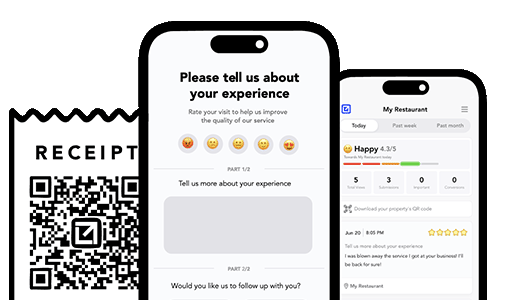Smart Ways to Get More Reviews [Guide]
Practical, proven ways for any business to get more authentic reviews.

TLDR: Bad feedback isn’t random, it’s driven by human psychology. People remember and share negative experiences more than positive ones, often to warn others, while happy customers rarely review unless prompted. This guide explains the triggers behind bad feedback, how to intercept it before it goes public, and how VisibleFeedback helps resolve issues privately while turning satisfied customers into public advocates.
Negative feedback spreads faster than positive for one simple reason: Negativity Bias. Humans naturally give more weight to negative experiences because they feel risk is more important to avoid than rewards are to gain. In other words, when something goes wrong, we remember it, and we share it.
There’s also a social component. People leave bad reviews because it feels like a public service, warning future customers about a potential problem. Combine that with the frustration of feeling unheard in person, and you’ve got a perfect recipe for a scathing review online.
👉 If this sounds familiar, our What To Do About Bad Reviews Guide shows how to turn even harsh public comments into opportunities to improve and win customers back.
Most businesses assume that if customers leave happy, they’ll leave a review. Unfortunately, that’s rarely true. Positive experiences are expected, they don’t feel noteworthy enough to write about. Unless you actively prompt satisfied customers, their feedback stays silent, while negative voices dominate the conversation.
This imbalance creates an inaccurate public picture of your business. You might have hundreds of happy customers, but if only one angry one speaks up, your reputation takes the hit.
When bad feedback does happen, knowing what to do with it is just as important as preventing it in the first place. Our guide walks you through responding in a way that protects your reputation and builds trust.
Negative reviews often stem from issues that seem small to you but loom large to your customers. The most common triggers include:
When people feel trapped and voiceless, they turn to the loudest platform they have, public review sites.
The good news? Most complaints can be resolved before they ever hit Yelp or Google. Here’s how:
The key is to make feedback easy and private. Customers are far less likely to leave a bad review if they feel heard.
Handling all this manually is tough, but VisibleFeedback simplifies the process:
It’s a system designed to protect your reputation and strengthen your customer relationships without extra hassle.
Negative feedback doesn’t have to be a death sentence. When you understand why customers complain and put systems in place to intercept issues early, you turn complaints into loyalty, and silence into 5-star advocacy.
🔥 Use VisibleFeedback to catch complaints before they explode, build trust, and grow your reputation the smart way.

Bad reviews can scare away potential customers. Intercept feedback in real time with VisibleFeedback.

Austin Spaeth is the founder of VisibleFeedback, a simple tool that helps brick-and-mortar businesses intercept negative reviews before they go public. With a background in software development and a passion for improving customer experience, Austin built VisibleFeedback to give business owners a frictionless way to collect private feedback and turn unhappy visitors into loyal advocates. When he’s not working on new features or writing about reputation strategy, he’s probably wrangling one of his six kids or sneaking in a beach day.
Whether you have no reviews, bad ones, or great ones, we’ll help you turn your feedback into growth.
No credit card required.
⛨ Trusted by over 137 local businesses like yours